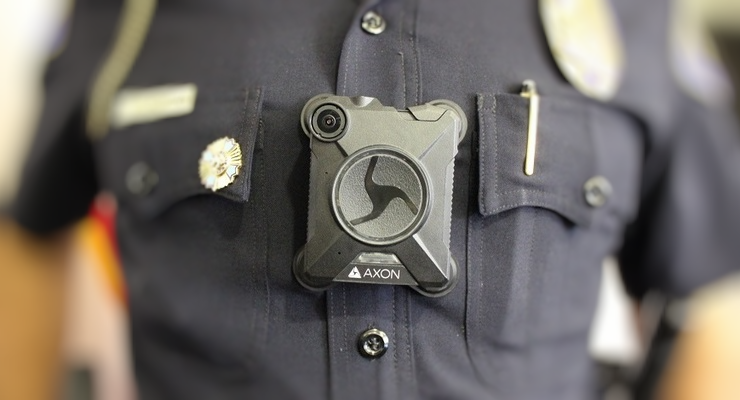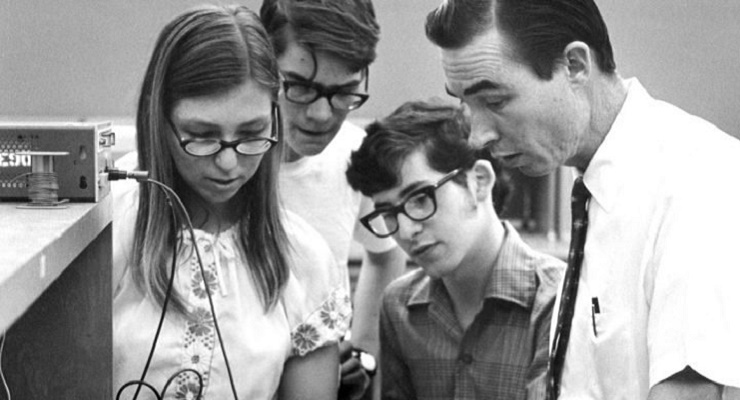
“One of the foundational early advances in computer science that makes our increasingly digital world possible began with a small course taught by Carver Mead at Caltech in the early 1970s”.
Mead (BS ’56, MS ’57, PhD ’60), the Gordon and Betty Moore Professor of Engineering and Applied Science, Emeritus, received the 2022 Kyoto Prize for Advanced Technology in honor of his “leading contributions to the establishment of the guiding principles for VLSI systems design.” VLSI, which stands for “very large-scale integration,” is the process of combining millions of transistors onto a single chip that forms an integrated circuit and it is the cornerstone of the computers the world relies on today. Mead, a Caltech Distinguished Alumnus, also received the National Medal of Technology in 2002 for his efforts (it is now known as the National Medal of Technology and Innovation).
Mead and computer engineer Lynn Conway wrote the book on the subject, Introduction to VLSI Systems, which was first published in 1978 and became the world standard textbook for chip design. However, the book and the VLSI revolution grew out of an electrical engineering course with an unassuming name, EE 281—Semiconductor Devices, which Mead began teaching to Caltech undergraduate and graduate students in 1971.
The course began with the curiosity of a graduate student, Richard Pashley (MS ’70, PhD ’74). In the early 1970s, Pashley’s PhD adviser, applied physicist James Mayer, had an office on the same floor of Steele Laboratory as Mead’s, so Pashley often ran into him.
“During my second year, I was taking a class in bipolar circuit design, and I wandered into Carver’s lab, and there were a bunch of students working with MOS [metal-oxide semiconductors – building computer chips], Pashley recalls. ” I said, ‘Why aren’t there any classes in this?’ And one of the students said, ‘Go talk to Carver.'”
So Pashley did. Mead told him to find 25 students interested in taking the class—if he could, Mead would teach it.
Interest was high. “It was no sweat to get 25 people to sign up,” Pashley remembers. However, keeping those students was a different matter.
“During the first lecture, Carver said, ‘This is going to be a little different than your usual class. I’m not going to just stand up here and lecture. You’re going to design an MOS circuit, and it’ll be fabricated at Intel. If it works, you pass. If it doesn’t, you fail,'” Pashley remembers. By the second session, two-thirds of the class had dropped out. Only nine students remained. “At that point, I was worried that Carver would say that he wouldn’t actually do it. But he took it as a sign that all of us who remained were dedicated, and we were.”
“That was an inherent part of Carver’s methodology,” says Doug Fairbairn, staff director of the Semiconductor Special Interest Group at the Computer History Museum who co-founded the company VLSI Technology in 1980. “You build things and test them and learn to improve them.”
In those days, computer chips were designed by hand in a painstaking and expensive process. After carefully drawing out various layers of a circuit on gridded Mylar, engineers had to transfer each individual layer of the pattern onto Rubylith—a Mylar sheet covered with a thin red layer. This layer could be cut into the desired pattern and peeled away from the Mylar to create the inverse pattern that would be photographed, shrunk, and then used as a mask for creating computer chips. Mead had devised a simple but effective computer program that could encode chip-design patterns for output to a Gerber plotter—at the time the only device by which a computer could generate highly precise complex geometric patterns. Mead’s design process produced more accurate patterns than the industry standard Rubylith, and it required vastly fewer human resources.
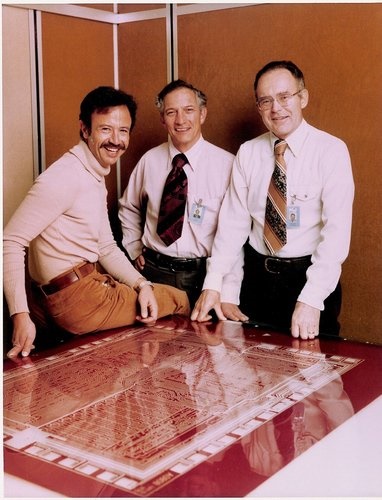
Credit: Intel Corporation (courtesy of the Computer History Museum)
Intel, which would become the world’s largest semiconductor chip manufacturer, was co-founded in 1968 by Mead’s friend, Caltech alumnus Gordon Moore (PhD ’54), and Robert Noyce (who had also co-founded Fairchild Semiconductor in 1957 and invented the integrated circuit in 1959). Mead had met Moore—who later became chair of Caltech’s Board of Trustees—during one of the latter’s recruiting expeditions to Caltech for Fairchild around 1960, and the two became fast friends, with Mead signing on to consult for Intel and make weekly trips up to the nascent Silicon Valley. One of the advantages of their congenial relationship was that Moore allowed Mead to use Intel’s factory to fabricate the chips designed by his students, giving them access to facilities unavailable to most universities—or anyone outside of the semiconductor industry.
Moore did not walk away empty-handed from the exchange, which served as an excellent recruiting tool for Intel. Many of the alumni of Mead’s class went on to take jobs at fast-growing Intel, including Pashley, Stuart Sando, Jr. (BS ’71, MS ’72), Edmund K. Cheng (MS ’73, PhD ’76), and Caltech trustee Ted Jenkins (BS ’65, MS ’66), and Distinguished Alumnus Gerhard Parker (BS ’65, MS ’66, PhD ’70).
One of the goals of the class was for students to design their chips to be as compact as possible given the expense of the materials and processing involved. “We used to say that ‘silicon real estate is a billion dollars an acre,'” Pashley says. “What we learned was the art of making these circuits small and living within the design rules.”
Each student had to design a dynamic shift register, which is a digital circuit that shifts information from one location to another through a cascade of flip-flops—elements that are stable in two distinct positions and can therefore store one “bit” of information (a 1 or a 0).
On computer chips, a series of transistors acts as a set miniature on–off switches. The patterns created by those switches allow information—in the form of electrical signals—to be transformed into an alternate set of electrical signals, processing the information they carry.
“The class taught us to think in three dimensions to create a circuit,” Pashley says. The circuits they designed had four types of layers: a diffusion layer, where impurities (known as dopants) had been introduced to the pure silicon wafer to modulate its conductivity; a polysilicon layer, which defined the control elements of the transistors; a metal layer, where the interconnecting wires were defined; and a contact layer, which made connections between conducting layers. “Back then, four layers could be used to build an integrated circuit. Now, you can have hundreds because they stack transistors on top of transistors like a high-rise building,” Pashley says.
The nine remaining students in that first-ever term of EE 281 in 1971 produced eight circuit designs—two students were married and collaborated on one of the designs. Mead grouped the student designs together on a single “multi-project chip,” had the patterns generated at a local Gerber shop, arranged for masks to be made at a mask vendor in Silicon Valley, and delivered the masks to Gerhard Parker at Intel, who arranged for them to be fabricated.
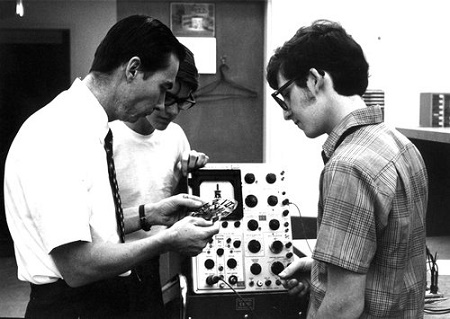
Credit: Courtesy of Caltech Archives
By January 1972, the fabrication was finished, and each student had received a chip and tested it in the lab. “Amazingly, they all worked!” Mead says. Thereafter, the class grew each year until Mead stopped teaching it in 1977. “Word got around that this was the future,” Mead says.
Two key things came from the class: firstly, on campus, Mead worked with Ivan Sutherland (MS ’60, formerly Caltech’s Fletcher Jones Professor of Computer Science and recipient of the 2012 Kyoto Prize) to found Caltech’s computer science option in 1976, with the VLSI course at the heart of the new option. “I was able to convince Ivan that integrated circuits would drive computer science, not the other way around,” Mead says.
Meanwhile, Mead continued to refine and advance his circuit design process through the course. “Every class I ever taught, I learned as much as the students,” Mead says, noting he also investigated fundamental questions raised by VLSI design with Martin Rem, one of two postdocs hired to work in the newly created computer science option.
“[Rem] and I together started the whole business of VLSI complexity theory: What does it mean to optimize a VLSI design? In the sense that you optimize a program? What are the cost metrics? What do you do? How do you assign weights to what’s important? And that got a whole way of thinking started,” Mead recounted in a 2020 interview with the Caltech Heritage Project.
In 1976, Xerox PARC (the Palo Alto-based research laboratory founded by Xerox in 1970) invited Mead to give a talk about VLSI in which he would provide an overview of EE 281 and the thesis projects that came out of it. It was there that Mead met Xerox’s Lynn Conway, with whom he would collaborate on Introduction to VLSI Systems.
After the talk, Conway suggested Mead write a book about VLSI; Mead replied that she should become a co-author, and they could write it together. At their next meeting, Conway showed him a stack of books about 2 feet high she had acquired that might have anything to do with what he had been teaching. “She said, ‘I’ve been through these books. There’s nothing like what you’re doing in any of them. I’ll be your co-author. … And that was the beginning of that collaboration,” Mead said in 2020. “I had been teaching the course already for six or seven years, and had it pretty well figured out. The first few chapters were mostly getting that part down on paper.” The later chapters included major contributions from Conway and others.
Work on the text began in August 1977. The first three chapters were used as course notes during the fall of 1977 in courses given by Mead at Caltech and by Carlo Sequin at UC Berkeley. The full text was later used during spring 1978 courses given by Ivan Sutherland at Caltech, by Robert Sproull at Carnegie Mellon University, and by Fred Rosenberger at Washington University in St. Louis.
In fall 1979, Conway and her colleagues at Xerox PARC organized MPC79, the creation of the first multi-university, multiproject chip. From universities around the world, 124 designers contributed 82 chip designs over the ARPANET, the precursor to today’s internet. Pat Castro, one of Mead’s collaborators earlier in his career, who was then in charge of the semiconductor factory at Hewlett-Packard, agreed to donate wafer fabrication. The packaged chips were shipped back to the designers in January 1980. That project became the model for MOSIS— a project funded by the Advanced Research Projects Agency that provided universities with chip fabrication services.
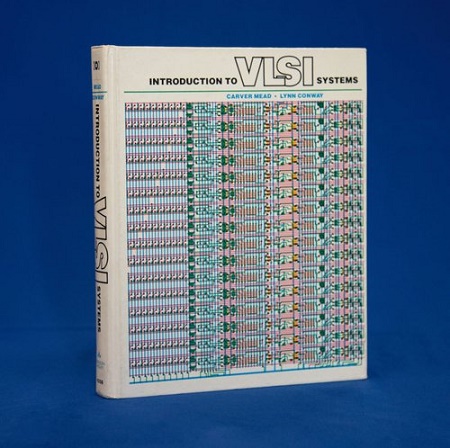 Upon the book’s completion in 1978, both Mead and Conway became cheerleaders for its ideas—and for a structured, modular methodology for chip design—by giving talks at various academic institutions, advising start-up companies and working with government agencies. Mead recalls being exhausted by that point, but the culture they had created was taking on a life of its own: universities were developing courses aimed at teaching VLSI, and private industry was producing advanced design tools and high-performance chips based on the Mead-Conway paradigm.
Upon the book’s completion in 1978, both Mead and Conway became cheerleaders for its ideas—and for a structured, modular methodology for chip design—by giving talks at various academic institutions, advising start-up companies and working with government agencies. Mead recalls being exhausted by that point, but the culture they had created was taking on a life of its own: universities were developing courses aimed at teaching VLSI, and private industry was producing advanced design tools and high-performance chips based on the Mead-Conway paradigm.
“We are literally 40 years later, and this methodology has become the standard in the industry,” says Fairbairn of the Computer History Museum. “Carver was always way ahead of the game. … The only mistake Carver ever made was being too early.”
Individuals who had taken EE 281 or heard Mead’s various lectures on the topic were spreading throughout the industry. Inspired by what they had learned, they went on to promote and, more importantly, to advance the technology in their own careers.
For example, after taking the very first EE 281 class in 1971, four of Mead’s students—Pashley, Sando, Lee Britton (BS ’73), and Yoshiaki Hagiwara (BS ’71, MS ’72, PhD ’75)—collaborated to design and build a 128-bit multicomparator chip fabricated at Intel.
After helping design the multicomparator as a student, Hagiwara, now a Caltech Distinguished Alumnus, developed an interest in electronic sensing systems and chose to work on a charge-coupled device (CCD) image sensor for his doctoral work. After taking a job at Sony in 1975, he developed technologies including a super light-sensitive image sensor that is still in use today.
“I believe all of these works became possible since I have received a very excellent education at Caltech, especially from Prof. C. A. Mead, Prof. James McCaldin [BS ’50, MS ’51, PhD ’54], and T. C. McGill [MS ’65, PhD ’69], who guided my career,” he wrote in an email.
“Carver’s EE 281 MOS design class changed my career from what would have been a research scientist at IBM or HP Labs into being a design engineer and general manager at Intel,” Pashley added. “I owe Carver Mead a debt of gratitude for his willingness to teach this class. His educational leadership has inspired many Caltech students.”
In addition, Mead, with two of his former students—Cheng and David L. Johannsen (BS ’78, MS ’78, PhD ’81)—in 1981 co-founded Silicon Compilers Inc., which developed software for taking specifications and using them to automatically generate integrated circuit designs. Johannsen’s PhD thesis laid out, for the first time, silicon compilation – the automatic generation of an integrated circuit by a computer program based on user specifications.
Cheng, in an interview with the Computer History Museum in 2014, said university professors in the ‘70s had a lot of relationships in the computer industry. Cheng recalled that Mead would bring in industry professionals to help guide his students as to what skills were needed in the real world. “So, they would say, well, you should think about doing this, try that. That turns out to be immensely helpful. Beats learning that stuff from grinding through math in a lecture class, let me tell you,” he said.
Mead began teaching at Caltech in 1958. He holds more than 80 U.S. patents and has written more than 100 scientific publications. This year, the Kyoto Prize recipients are Mead, in advanced technology; population biologist Bryan T. Grenfell of Princeton University in basic sciences; and musician Zakir Hussain in arts and philosophy. In 2007, the Kyoto Prize was awarded to Hiroo Kanamori, the John E. and Hazel S. Smits Professor of Geophysics, Emeritus, in honor of his “significant contributions to understanding the physical processes of earthquakes and developing seismic hazard mitigation systems to protect human life.” In 2019, Caltech astrophysicist James Gunn (now at Princeton University) received the Kyoto Prize for his leadership in the Sloan Digital Sky Survey, which produced a 3-D digital cosmic map encompassing a broad region.
“The Kyoto Prize is especially precious to me because it recognizes contribution to, not only technology, but, even more, to the human spirit,” Mead says.












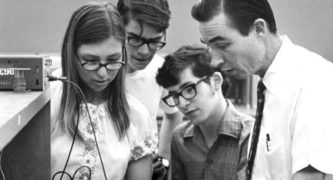

 2 comments
2 comments
